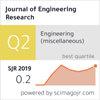Conservation-oriented integrated approach for structural stability assessment of complex historic masonry structures
IF 2.2
4区 工程技术
Q3 ENGINEERING, MULTIDISCIPLINARY
引用次数: 0
Abstract
The paper presents a multidisciplinary approach for diagnosing the structural stability of the Takiyya of Ibrahim al-Gulshani in Historic Cairo using geometric and architectural documentation, field survey, laboratory tests, and numerical analyses under static and seismic conditions. The Takiyya, built during the Mamluk period, is an important medieval architectural complex in Egypt and has undergone multiple renovations. The field-testing includes geotechnical and geophysical investigations to evaluate the properties of the bearing soil beneath the monument. A 3D survey using Terrestrial Laser Scanning was employed to record Takiyya’s geometry. Terrestrial photogrammetry and high-resolution images accompanied by an in-situ damage survey were used to document cracking levels, stone weathering, and identification of decay patterns. Laboratory tests were conducted to assess the mineral composition, physical and mechanical properties of the construction materials to enable structural assessments. Data appraisal and integration into architectural drawings was used for mapping degradation patterns and the preservation state of the building. The documentation procedures combined with experiments were then employed to develop a model for structural analysis. Three-dimensional finite element numerical simulations employing macro-modelling approaches were performed for the Takiyya structures under various loading conditions, including modelling the bearing soil, resulting in good agreement with in-situ recorded structure damage patterns. The static and seismic nonlinear analyses helped identify the causes and effects of the current structural deficiencies. The adopted methodologies provided large amounts of information, permitting an improved understanding of existing damage and the assessment of the preservation state of the masonry structure. This project exists thanks to the Egyptian Ministry of Tourism and Antiquities (MoTA) and is funded by World Monument Fund (WMF) through various donors.
以保护为导向的复杂历史砖石结构稳定性综合评估方法
本文介绍了一种多学科方法,通过几何和建筑文献、实地调查、实验室测试以及静态和地震条件下的数值分析,来诊断开罗历史上易卜拉欣古尔沙尼塔基亚的结构稳定性。Takiyya建于马穆鲁克时期,是埃及重要的中世纪建筑群,经历了多次翻新。现场测试包括岩土和地球物理调查,以评估纪念碑下承载土壤的性质。使用地面激光扫描的三维测量被用来记录泷谷的几何形状。地面摄影测量和高分辨率图像伴随着现场损伤调查被用来记录裂缝水平、石头风化和腐烂模式的识别。进行了实验室测试,以评估建筑材料的矿物组成、物理和机械性能,以便进行结构评估。数据评估和整合到建筑图纸中用于映射建筑物的退化模式和保存状态。然后采用文献程序结合实验建立结构分析模型。采用宏观建模方法对不同荷载条件下的Takiyya结构进行了三维有限元数值模拟,包括对承载土进行建模,结果与现场记录的结构损伤模式吻合较好。静力和地震非线性分析有助于确定当前结构缺陷的原因和影响。所采用的方法提供了大量的信息,可以提高对现有损伤的理解和对砌体结构保存状态的评估。这个项目的存在要感谢埃及旅游和古物部(MoTA),并由世界纪念碑基金(WMF)通过各种捐助者资助。
本文章由计算机程序翻译,如有差异,请以英文原文为准。
求助全文
约1分钟内获得全文
求助全文
来源期刊

Journal of Engineering Research
ENGINEERING, MULTIDISCIPLINARY-
CiteScore
1.60
自引率
10.00%
发文量
181
审稿时长
20 weeks
期刊介绍:
Journal of Engineering Research (JER) is a international, peer reviewed journal which publishes full length original research papers, reviews, case studies related to all areas of Engineering such as: Civil, Mechanical, Industrial, Electrical, Computer, Chemical, Petroleum, Aerospace, Architectural, Biomedical, Coastal, Environmental, Marine & Ocean, Metallurgical & Materials, software, Surveying, Systems and Manufacturing Engineering. In particular, JER focuses on innovative approaches and methods that contribute to solving the environmental and manufacturing problems, which exist primarily in the Arabian Gulf region and the Middle East countries. Kuwait University used to publish the Journal "Kuwait Journal of Science and Engineering" (ISSN: 1024-8684), which included Science and Engineering articles since 1974. In 2011 the decision was taken to split KJSE into two independent Journals - "Journal of Engineering Research "(JER) and "Kuwait Journal of Science" (KJS).
 求助内容:
求助内容: 应助结果提醒方式:
应助结果提醒方式:


